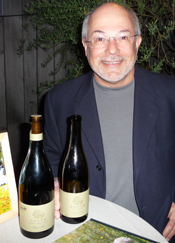Tony Soter sheds some weight [carbon footprint]
 Tony Soter shed some unnecessary weight from one year to the next–in his bottles.
Tony Soter shed some unnecessary weight from one year to the next–in his bottles.
The Oregon vintner shipped his 2007 Pinot Noirs in bottles weighing 900g, more than the 750g of wine in the bottle. But for his 2008s, which are being released soon, the bottles will weigh 600g (both bottles, pictured right). Needless to say, the reduced packaging mass greatly reduces the carbon footprint of the wine.
“The time has passed that you can try to impress people with the substance of the bottle as opposed to what is in the bottle,” he said.
He also thought it odd to import tons of empty glass bottles from France, so started sourcing his bottles locally. One new facility near Portland is getting underway making recycled glass from hydro-electric power. Currently, he is sourcing the glass from Seattle. Other vintners in the area are also taking steps to make their bottles more lightweight, he said.
Here at the Dr. Vino World Headquarters, we raise an ultralight crystal stem of Willamette Valley Pinot Noir in their honor!




On April 15th, 2010 at 3:44 pm ,Christian G.E. Schiller wrote:
Interesting. Excellent wines. I tasted his wines recently and reviewed them here. http://www.schiller-wine.blogspot.com/2009/11/wine-tasting-soter-wines-from-oregon-at.html
On April 15th, 2010 at 7:31 pm ,John wrote:
Old news, Tyler. Six-hundred grams? State of the art in glass is about 300g these days, though these ultra-light bottles could be more attractive. And the price differential between local and Euro-denominated glass is enough reason for most to buy from suppliers closer to home, not to mention the cost of comp claims for workers handling 50 lb. cases.
We started to make the switch to lighter glass for cost and ecological reasons back in 2007; I blogged about it to 2008 – both before I ever read any of your carbon footprint analyses.
BTW – I’m picking nits here, but the density of wine is usually under 0.96 g/mL, so the weight of the contents of a 750 mL bottle is less than 730 g.
On April 15th, 2010 at 9:14 pm ,Dr. Vino wrote:
John –
Actually, it is new news for Soter since they just effected the change.
Could they use an even lighter bottle? Certainly. But did they just slice a third useless weight off? Yes. Many other (high-end) producers still bottle in ultra-heavy bottles despite high costs, as you note, and high GHG emissions. So when one shaves some weight, it’s worth of a tip o’ the hat. Congratulations to you on making that change. How heavy are your bottles?
On April 15th, 2010 at 10:03 pm ,Ed Thralls wrote:
Agreed, Dr Vino, and Bergstrom should follow suit as their bottles are the biggest and heaviest I’ve seen for cripes sake!
On April 15th, 2010 at 11:39 pm ,John wrote:
Hi Tyler – we switched from an 850 gram bottle to two different packages. About one third of our wine goes into a bottle weighing 535g. The remainder goes into a bottle that weighs 485g. Saves us about 10 lb./case. Pretty significant, as the wine alone is about 20 lb./case.
Going forward I plan to stick with glass. It is easier to recycle than the alternatives.
On April 16th, 2010 at 9:40 am ,Gerry Dawes wrote:
Amazing how people who ought to have known better in the first place change their thinking when the wind starts to blow from a different direction. Now, in addition to getting rid of super-heavy bottles (duh, the shipping costs alone for such pretentiousness), we will soon see a massive shift away from the “new French oak” religion, no because inexpert use of oak screws up the wine, but because new oak costs too bloody much. As long aw we are on the subject of heavy bottles, my partial solution to the outrageously high alcohol levels in California wines–in addition to stopping harvesting irrigated, overripe fruit–is to put these charicature trophy wines in 500ml bottles. A half liter is about all two people can support these days, especially in restaurants (many have to drive), so that would stop leaving a fourth to a third of the bottle undrunk on the table. It would allow producers to simultaneously drop their price per bottle by about 25% and make more bottles available to the public for wineries who have tight allocations (the few left who do). Sure, they would still keep bottling in 750ml. for collectors and wine aficionados who want to cellar those wines.
And, while we are at the carbon footprint thing, how about doing away with plastic stoppers, which are going to end up in those huge floating plastic trash dumps in the Atlantic and Pacific Ocean? And the carbon footprint on natural cork is so far above that of the horrid screw-top closure that, now that TCA is under control (of the samples I am sent to taste for articles about Spanish wines, I can’t remember when the last cork-taint wine turned up), there is not real excuse for continuing the screw-top madness. (Yeh, I know they are easier to open, just don’t slice your finger on that aluminum that is going to end up in the landfill.)